FSBM: Ryanair's Cost Management - A Management Accounting Report
VerifiedAdded on 2023/06/12
|14
|3031
|149
Report
AI Summary
This management accounting report analyzes Ryanair's cost management strategies, budgeting techniques, and financial reporting methods. It examines cost accounting systems, inventory management, and job costing within Ryanair's operational context. The report discusses the advantages and disadvantages of various budgeting tools and their implementation in Ryanair, comparing them with Southwest Airlines. It also includes an analysis of product costs under absorption and marginal costing techniques, presenting income statements under both methods. The report concludes with a cash budget analysis, providing insights into Ryanair's cash flow management. Desklib offers similar solved assignments and past papers for students.
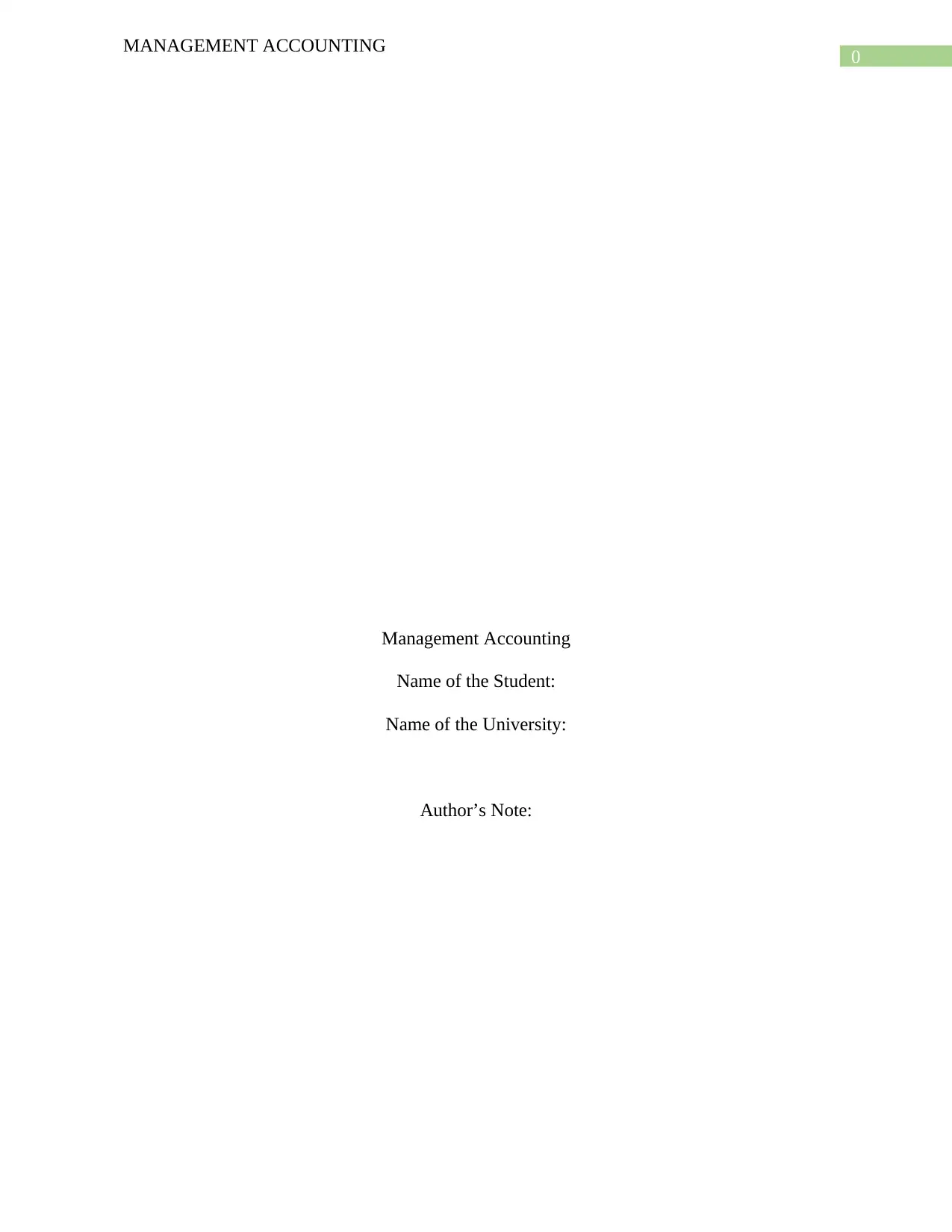
0
MANAGEMENT ACCOUNTING
Management Accounting
Name of the Student:
Name of the University:
Author’s Note:
MANAGEMENT ACCOUNTING
Management Accounting
Name of the Student:
Name of the University:
Author’s Note:
Paraphrase This Document
Need a fresh take? Get an instant paraphrase of this document with our AI Paraphraser
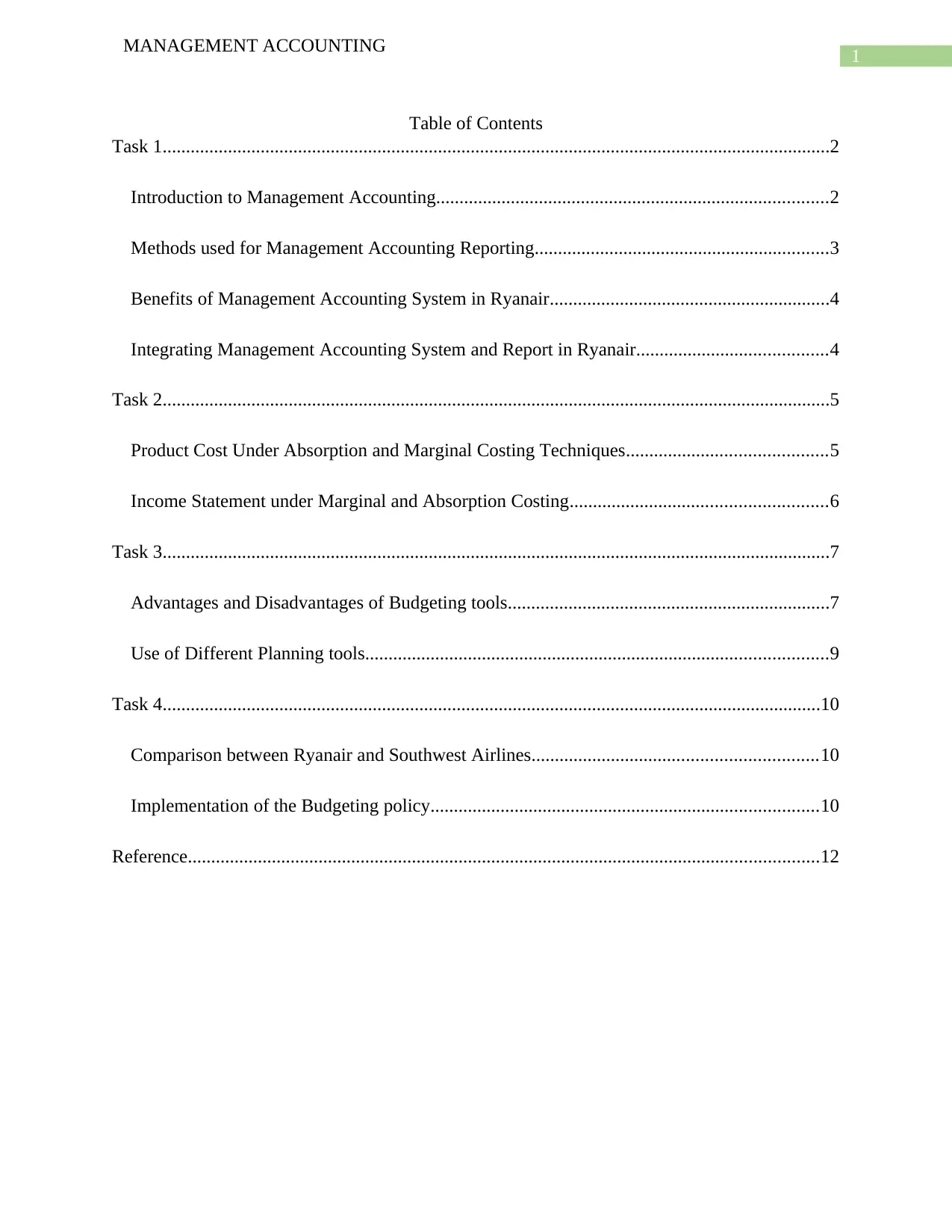
1
MANAGEMENT ACCOUNTING
Table of Contents
Task 1...............................................................................................................................................2
Introduction to Management Accounting....................................................................................2
Methods used for Management Accounting Reporting...............................................................3
Benefits of Management Accounting System in Ryanair............................................................4
Integrating Management Accounting System and Report in Ryanair.........................................4
Task 2...............................................................................................................................................5
Product Cost Under Absorption and Marginal Costing Techniques...........................................5
Income Statement under Marginal and Absorption Costing.......................................................6
Task 3...............................................................................................................................................7
Advantages and Disadvantages of Budgeting tools.....................................................................7
Use of Different Planning tools...................................................................................................9
Task 4.............................................................................................................................................10
Comparison between Ryanair and Southwest Airlines.............................................................10
Implementation of the Budgeting policy...................................................................................10
Reference.......................................................................................................................................12
MANAGEMENT ACCOUNTING
Table of Contents
Task 1...............................................................................................................................................2
Introduction to Management Accounting....................................................................................2
Methods used for Management Accounting Reporting...............................................................3
Benefits of Management Accounting System in Ryanair............................................................4
Integrating Management Accounting System and Report in Ryanair.........................................4
Task 2...............................................................................................................................................5
Product Cost Under Absorption and Marginal Costing Techniques...........................................5
Income Statement under Marginal and Absorption Costing.......................................................6
Task 3...............................................................................................................................................7
Advantages and Disadvantages of Budgeting tools.....................................................................7
Use of Different Planning tools...................................................................................................9
Task 4.............................................................................................................................................10
Comparison between Ryanair and Southwest Airlines.............................................................10
Implementation of the Budgeting policy...................................................................................10
Reference.......................................................................................................................................12
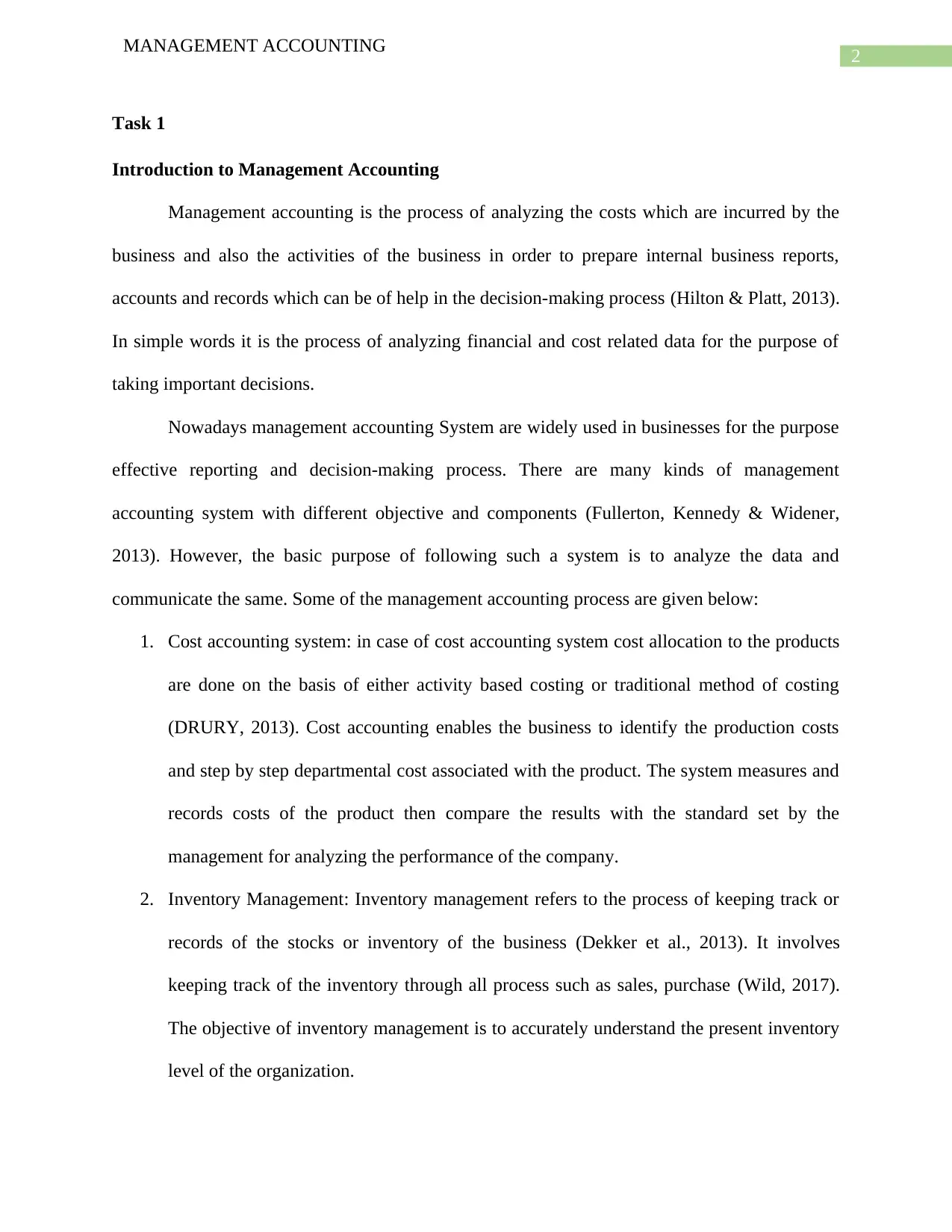
2
MANAGEMENT ACCOUNTING
Task 1
Introduction to Management Accounting
Management accounting is the process of analyzing the costs which are incurred by the
business and also the activities of the business in order to prepare internal business reports,
accounts and records which can be of help in the decision-making process (Hilton & Platt, 2013).
In simple words it is the process of analyzing financial and cost related data for the purpose of
taking important decisions.
Nowadays management accounting System are widely used in businesses for the purpose
effective reporting and decision-making process. There are many kinds of management
accounting system with different objective and components (Fullerton, Kennedy & Widener,
2013). However, the basic purpose of following such a system is to analyze the data and
communicate the same. Some of the management accounting process are given below:
1. Cost accounting system: in case of cost accounting system cost allocation to the products
are done on the basis of either activity based costing or traditional method of costing
(DRURY, 2013). Cost accounting enables the business to identify the production costs
and step by step departmental cost associated with the product. The system measures and
records costs of the product then compare the results with the standard set by the
management for analyzing the performance of the company.
2. Inventory Management: Inventory management refers to the process of keeping track or
records of the stocks or inventory of the business (Dekker et al., 2013). It involves
keeping track of the inventory through all process such as sales, purchase (Wild, 2017).
The objective of inventory management is to accurately understand the present inventory
level of the organization.
MANAGEMENT ACCOUNTING
Task 1
Introduction to Management Accounting
Management accounting is the process of analyzing the costs which are incurred by the
business and also the activities of the business in order to prepare internal business reports,
accounts and records which can be of help in the decision-making process (Hilton & Platt, 2013).
In simple words it is the process of analyzing financial and cost related data for the purpose of
taking important decisions.
Nowadays management accounting System are widely used in businesses for the purpose
effective reporting and decision-making process. There are many kinds of management
accounting system with different objective and components (Fullerton, Kennedy & Widener,
2013). However, the basic purpose of following such a system is to analyze the data and
communicate the same. Some of the management accounting process are given below:
1. Cost accounting system: in case of cost accounting system cost allocation to the products
are done on the basis of either activity based costing or traditional method of costing
(DRURY, 2013). Cost accounting enables the business to identify the production costs
and step by step departmental cost associated with the product. The system measures and
records costs of the product then compare the results with the standard set by the
management for analyzing the performance of the company.
2. Inventory Management: Inventory management refers to the process of keeping track or
records of the stocks or inventory of the business (Dekker et al., 2013). It involves
keeping track of the inventory through all process such as sales, purchase (Wild, 2017).
The objective of inventory management is to accurately understand the present inventory
level of the organization.
⊘ This is a preview!⊘
Do you want full access?
Subscribe today to unlock all pages.

Trusted by 1+ million students worldwide
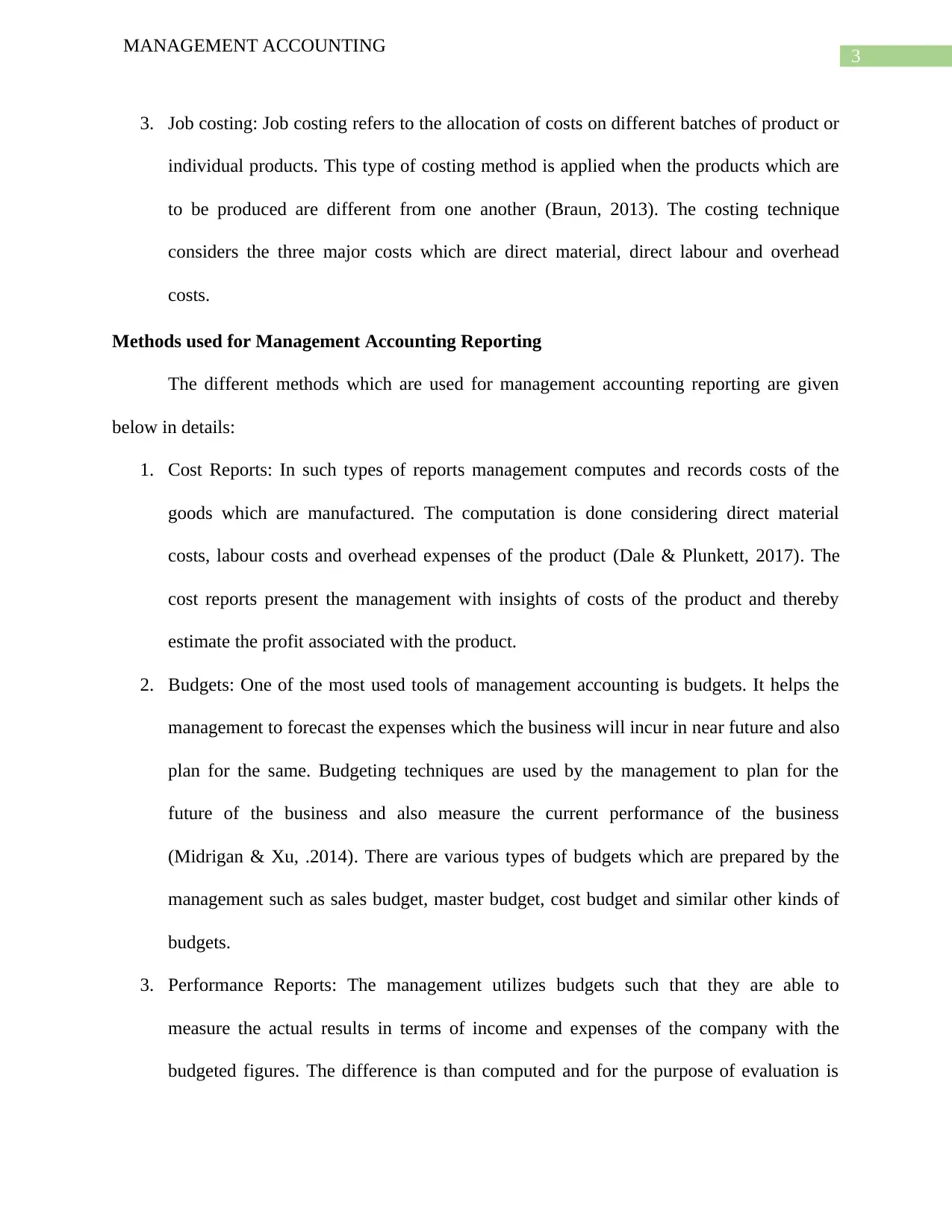
3
MANAGEMENT ACCOUNTING
3. Job costing: Job costing refers to the allocation of costs on different batches of product or
individual products. This type of costing method is applied when the products which are
to be produced are different from one another (Braun, 2013). The costing technique
considers the three major costs which are direct material, direct labour and overhead
costs.
Methods used for Management Accounting Reporting
The different methods which are used for management accounting reporting are given
below in details:
1. Cost Reports: In such types of reports management computes and records costs of the
goods which are manufactured. The computation is done considering direct material
costs, labour costs and overhead expenses of the product (Dale & Plunkett, 2017). The
cost reports present the management with insights of costs of the product and thereby
estimate the profit associated with the product.
2. Budgets: One of the most used tools of management accounting is budgets. It helps the
management to forecast the expenses which the business will incur in near future and also
plan for the same. Budgeting techniques are used by the management to plan for the
future of the business and also measure the current performance of the business
(Midrigan & Xu, .2014). There are various types of budgets which are prepared by the
management such as sales budget, master budget, cost budget and similar other kinds of
budgets.
3. Performance Reports: The management utilizes budgets such that they are able to
measure the actual results in terms of income and expenses of the company with the
budgeted figures. The difference is than computed and for the purpose of evaluation is
MANAGEMENT ACCOUNTING
3. Job costing: Job costing refers to the allocation of costs on different batches of product or
individual products. This type of costing method is applied when the products which are
to be produced are different from one another (Braun, 2013). The costing technique
considers the three major costs which are direct material, direct labour and overhead
costs.
Methods used for Management Accounting Reporting
The different methods which are used for management accounting reporting are given
below in details:
1. Cost Reports: In such types of reports management computes and records costs of the
goods which are manufactured. The computation is done considering direct material
costs, labour costs and overhead expenses of the product (Dale & Plunkett, 2017). The
cost reports present the management with insights of costs of the product and thereby
estimate the profit associated with the product.
2. Budgets: One of the most used tools of management accounting is budgets. It helps the
management to forecast the expenses which the business will incur in near future and also
plan for the same. Budgeting techniques are used by the management to plan for the
future of the business and also measure the current performance of the business
(Midrigan & Xu, .2014). There are various types of budgets which are prepared by the
management such as sales budget, master budget, cost budget and similar other kinds of
budgets.
3. Performance Reports: The management utilizes budgets such that they are able to
measure the actual results in terms of income and expenses of the company with the
budgeted figures. The difference is than computed and for the purpose of evaluation is
Paraphrase This Document
Need a fresh take? Get an instant paraphrase of this document with our AI Paraphraser
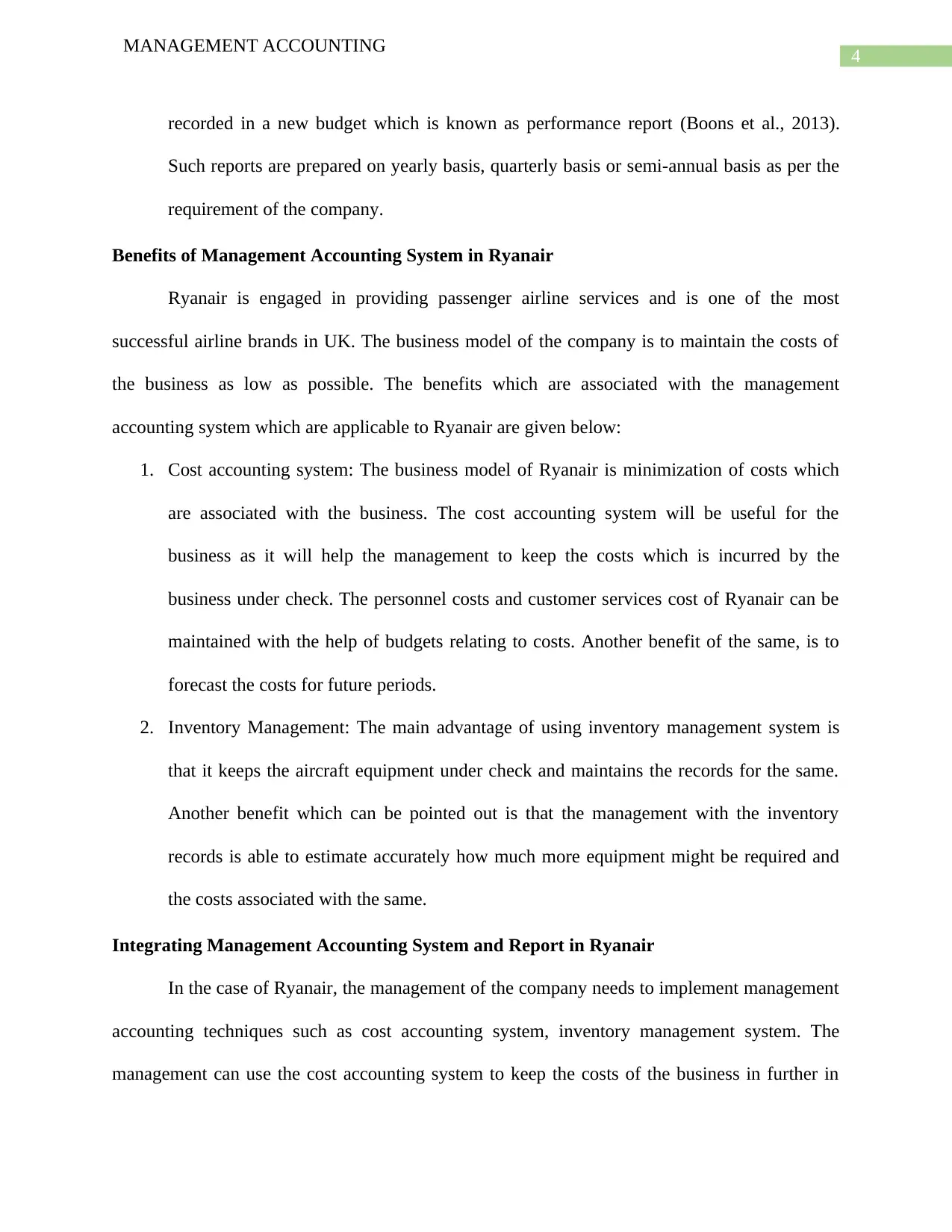
4
MANAGEMENT ACCOUNTING
recorded in a new budget which is known as performance report (Boons et al., 2013).
Such reports are prepared on yearly basis, quarterly basis or semi-annual basis as per the
requirement of the company.
Benefits of Management Accounting System in Ryanair
Ryanair is engaged in providing passenger airline services and is one of the most
successful airline brands in UK. The business model of the company is to maintain the costs of
the business as low as possible. The benefits which are associated with the management
accounting system which are applicable to Ryanair are given below:
1. Cost accounting system: The business model of Ryanair is minimization of costs which
are associated with the business. The cost accounting system will be useful for the
business as it will help the management to keep the costs which is incurred by the
business under check. The personnel costs and customer services cost of Ryanair can be
maintained with the help of budgets relating to costs. Another benefit of the same, is to
forecast the costs for future periods.
2. Inventory Management: The main advantage of using inventory management system is
that it keeps the aircraft equipment under check and maintains the records for the same.
Another benefit which can be pointed out is that the management with the inventory
records is able to estimate accurately how much more equipment might be required and
the costs associated with the same.
Integrating Management Accounting System and Report in Ryanair
In the case of Ryanair, the management of the company needs to implement management
accounting techniques such as cost accounting system, inventory management system. The
management can use the cost accounting system to keep the costs of the business in further in
MANAGEMENT ACCOUNTING
recorded in a new budget which is known as performance report (Boons et al., 2013).
Such reports are prepared on yearly basis, quarterly basis or semi-annual basis as per the
requirement of the company.
Benefits of Management Accounting System in Ryanair
Ryanair is engaged in providing passenger airline services and is one of the most
successful airline brands in UK. The business model of the company is to maintain the costs of
the business as low as possible. The benefits which are associated with the management
accounting system which are applicable to Ryanair are given below:
1. Cost accounting system: The business model of Ryanair is minimization of costs which
are associated with the business. The cost accounting system will be useful for the
business as it will help the management to keep the costs which is incurred by the
business under check. The personnel costs and customer services cost of Ryanair can be
maintained with the help of budgets relating to costs. Another benefit of the same, is to
forecast the costs for future periods.
2. Inventory Management: The main advantage of using inventory management system is
that it keeps the aircraft equipment under check and maintains the records for the same.
Another benefit which can be pointed out is that the management with the inventory
records is able to estimate accurately how much more equipment might be required and
the costs associated with the same.
Integrating Management Accounting System and Report in Ryanair
In the case of Ryanair, the management of the company needs to implement management
accounting techniques such as cost accounting system, inventory management system. The
management can use the cost accounting system to keep the costs of the business in further in
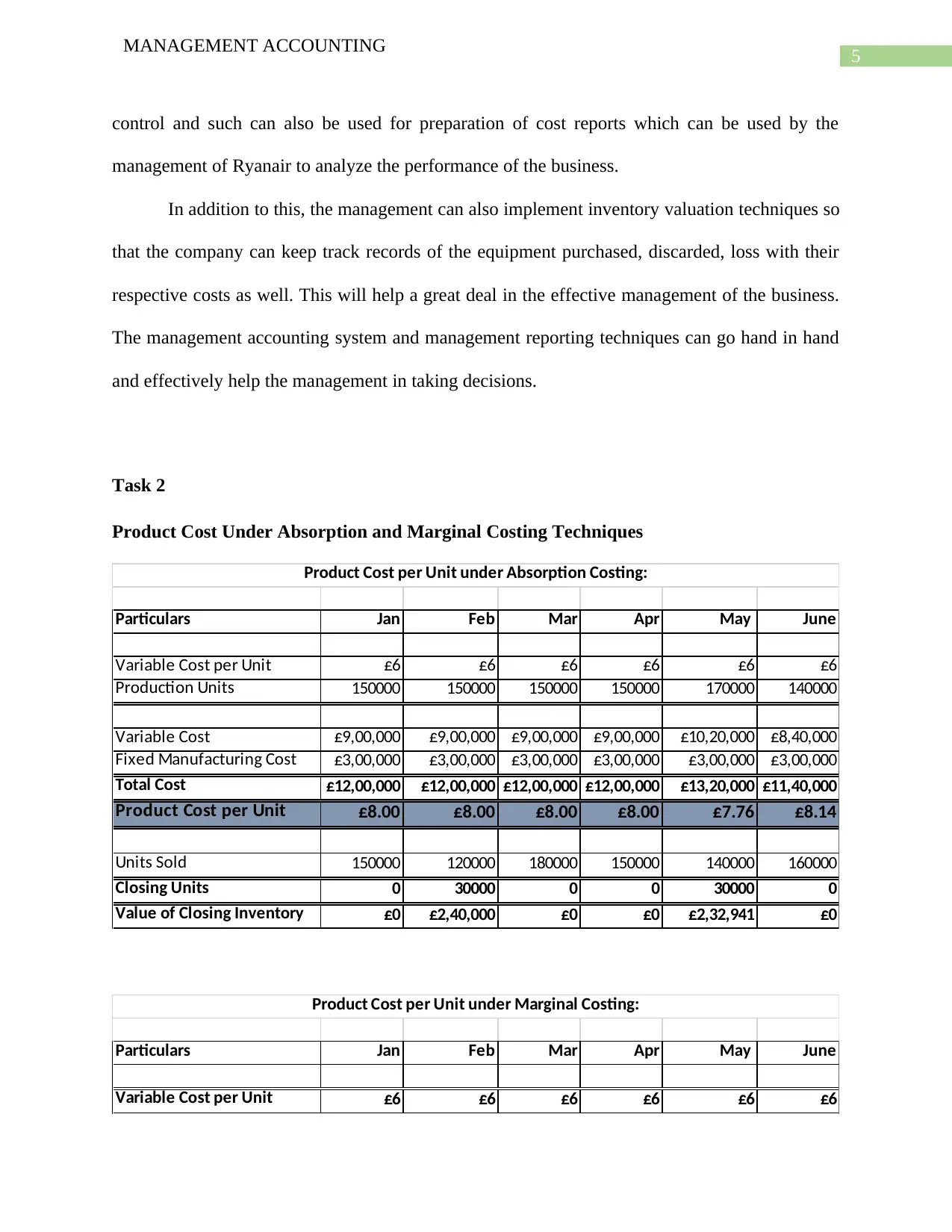
5
MANAGEMENT ACCOUNTING
control and such can also be used for preparation of cost reports which can be used by the
management of Ryanair to analyze the performance of the business.
In addition to this, the management can also implement inventory valuation techniques so
that the company can keep track records of the equipment purchased, discarded, loss with their
respective costs as well. This will help a great deal in the effective management of the business.
The management accounting system and management reporting techniques can go hand in hand
and effectively help the management in taking decisions.
Task 2
Product Cost Under Absorption and Marginal Costing Techniques
Particulars Jan Feb Mar Apr May June
Variable Cost per Unit £6 £6 £6 £6 £6 £6
Production Units 150000 150000 150000 150000 170000 140000
Variable Cost £9,00,000 £9,00,000 £9,00,000 £9,00,000 £10,20,000 £8,40,000
Fixed Manufacturing Cost £3,00,000 £3,00,000 £3,00,000 £3,00,000 £3,00,000 £3,00,000
Total Cost £12,00,000 £12,00,000 £12,00,000 £12,00,000 £13,20,000 £11,40,000
Product Cost per Unit £8.00 £8.00 £8.00 £8.00 £7.76 £8.14
Units Sold 150000 120000 180000 150000 140000 160000
Closing Units 0 30000 0 0 30000 0
Value of Closing Inventory £0 £2,40,000 £0 £0 £2,32,941 £0
Product Cost per Unit under Absorption Costing:
Particulars Jan Feb Mar Apr May June
Variable Cost per Unit £6 £6 £6 £6 £6 £6
Product Cost per Unit under Marginal Costing:
MANAGEMENT ACCOUNTING
control and such can also be used for preparation of cost reports which can be used by the
management of Ryanair to analyze the performance of the business.
In addition to this, the management can also implement inventory valuation techniques so
that the company can keep track records of the equipment purchased, discarded, loss with their
respective costs as well. This will help a great deal in the effective management of the business.
The management accounting system and management reporting techniques can go hand in hand
and effectively help the management in taking decisions.
Task 2
Product Cost Under Absorption and Marginal Costing Techniques
Particulars Jan Feb Mar Apr May June
Variable Cost per Unit £6 £6 £6 £6 £6 £6
Production Units 150000 150000 150000 150000 170000 140000
Variable Cost £9,00,000 £9,00,000 £9,00,000 £9,00,000 £10,20,000 £8,40,000
Fixed Manufacturing Cost £3,00,000 £3,00,000 £3,00,000 £3,00,000 £3,00,000 £3,00,000
Total Cost £12,00,000 £12,00,000 £12,00,000 £12,00,000 £13,20,000 £11,40,000
Product Cost per Unit £8.00 £8.00 £8.00 £8.00 £7.76 £8.14
Units Sold 150000 120000 180000 150000 140000 160000
Closing Units 0 30000 0 0 30000 0
Value of Closing Inventory £0 £2,40,000 £0 £0 £2,32,941 £0
Product Cost per Unit under Absorption Costing:
Particulars Jan Feb Mar Apr May June
Variable Cost per Unit £6 £6 £6 £6 £6 £6
Product Cost per Unit under Marginal Costing:
⊘ This is a preview!⊘
Do you want full access?
Subscribe today to unlock all pages.

Trusted by 1+ million students worldwide
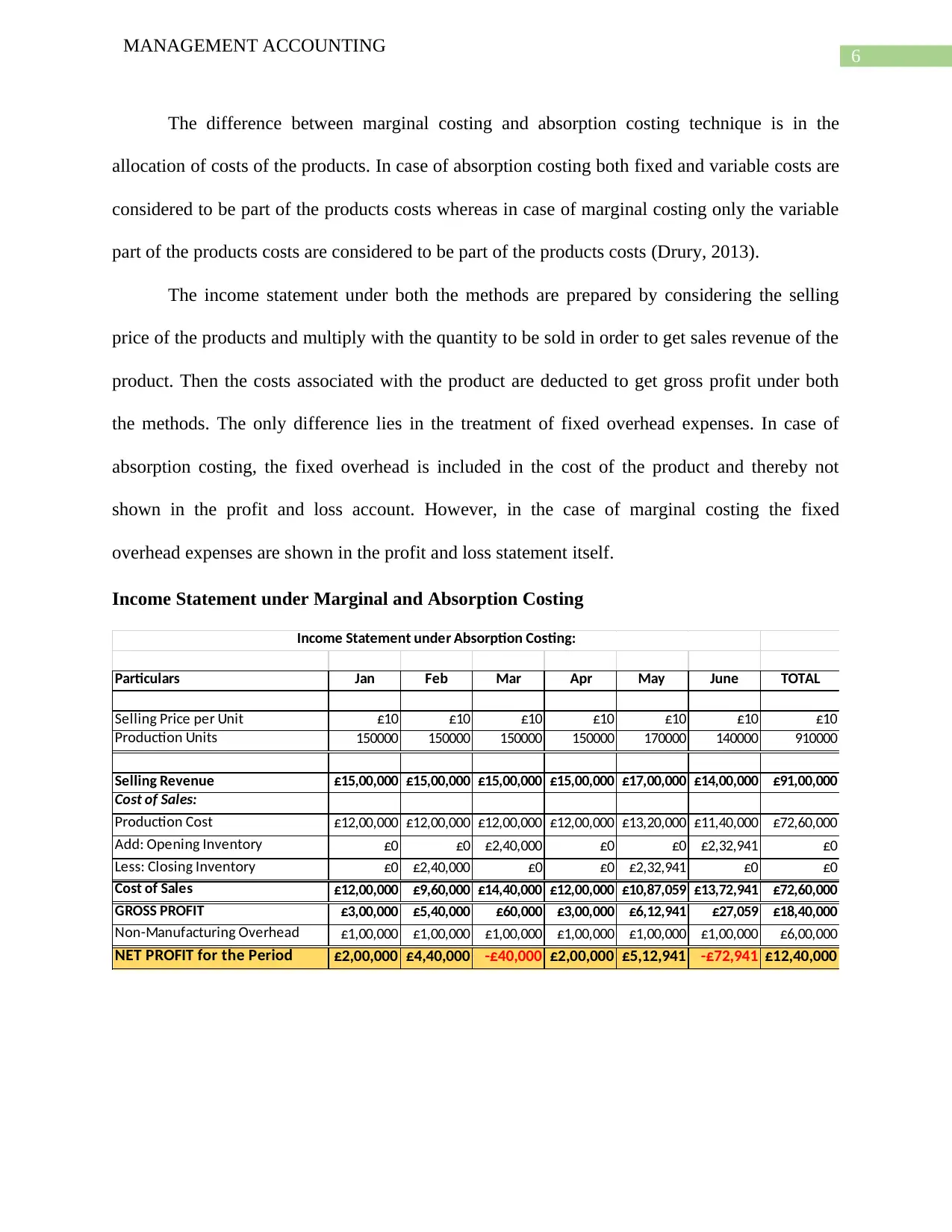
6
MANAGEMENT ACCOUNTING
The difference between marginal costing and absorption costing technique is in the
allocation of costs of the products. In case of absorption costing both fixed and variable costs are
considered to be part of the products costs whereas in case of marginal costing only the variable
part of the products costs are considered to be part of the products costs (Drury, 2013).
The income statement under both the methods are prepared by considering the selling
price of the products and multiply with the quantity to be sold in order to get sales revenue of the
product. Then the costs associated with the product are deducted to get gross profit under both
the methods. The only difference lies in the treatment of fixed overhead expenses. In case of
absorption costing, the fixed overhead is included in the cost of the product and thereby not
shown in the profit and loss account. However, in the case of marginal costing the fixed
overhead expenses are shown in the profit and loss statement itself.
Income Statement under Marginal and Absorption Costing
Particulars Jan Feb Mar Apr May June TOTAL
Selling Price per Unit £10 £10 £10 £10 £10 £10 £10
Production Units 150000 150000 150000 150000 170000 140000 910000
Selling Revenue £15,00,000 £15,00,000 £15,00,000 £15,00,000 £17,00,000 £14,00,000 £91,00,000
Cost of Sales:
Production Cost £12,00,000 £12,00,000 £12,00,000 £12,00,000 £13,20,000 £11,40,000 £72,60,000
Add: Opening Inventory £0 £0 £2,40,000 £0 £0 £2,32,941 £0
Less: Closing Inventory £0 £2,40,000 £0 £0 £2,32,941 £0 £0
Cost of Sales £12,00,000 £9,60,000 £14,40,000 £12,00,000 £10,87,059 £13,72,941 £72,60,000
GROSS PROFIT £3,00,000 £5,40,000 £60,000 £3,00,000 £6,12,941 £27,059 £18,40,000
Non-Manufacturing Overhead £1,00,000 £1,00,000 £1,00,000 £1,00,000 £1,00,000 £1,00,000 £6,00,000
NET PROFIT for the Period £2,00,000 £4,40,000 -£40,000 £2,00,000 £5,12,941 -£72,941 £12,40,000
Income Statement under Absorption Costing:
MANAGEMENT ACCOUNTING
The difference between marginal costing and absorption costing technique is in the
allocation of costs of the products. In case of absorption costing both fixed and variable costs are
considered to be part of the products costs whereas in case of marginal costing only the variable
part of the products costs are considered to be part of the products costs (Drury, 2013).
The income statement under both the methods are prepared by considering the selling
price of the products and multiply with the quantity to be sold in order to get sales revenue of the
product. Then the costs associated with the product are deducted to get gross profit under both
the methods. The only difference lies in the treatment of fixed overhead expenses. In case of
absorption costing, the fixed overhead is included in the cost of the product and thereby not
shown in the profit and loss account. However, in the case of marginal costing the fixed
overhead expenses are shown in the profit and loss statement itself.
Income Statement under Marginal and Absorption Costing
Particulars Jan Feb Mar Apr May June TOTAL
Selling Price per Unit £10 £10 £10 £10 £10 £10 £10
Production Units 150000 150000 150000 150000 170000 140000 910000
Selling Revenue £15,00,000 £15,00,000 £15,00,000 £15,00,000 £17,00,000 £14,00,000 £91,00,000
Cost of Sales:
Production Cost £12,00,000 £12,00,000 £12,00,000 £12,00,000 £13,20,000 £11,40,000 £72,60,000
Add: Opening Inventory £0 £0 £2,40,000 £0 £0 £2,32,941 £0
Less: Closing Inventory £0 £2,40,000 £0 £0 £2,32,941 £0 £0
Cost of Sales £12,00,000 £9,60,000 £14,40,000 £12,00,000 £10,87,059 £13,72,941 £72,60,000
GROSS PROFIT £3,00,000 £5,40,000 £60,000 £3,00,000 £6,12,941 £27,059 £18,40,000
Non-Manufacturing Overhead £1,00,000 £1,00,000 £1,00,000 £1,00,000 £1,00,000 £1,00,000 £6,00,000
NET PROFIT for the Period £2,00,000 £4,40,000 -£40,000 £2,00,000 £5,12,941 -£72,941 £12,40,000
Income Statement under Absorption Costing:
Paraphrase This Document
Need a fresh take? Get an instant paraphrase of this document with our AI Paraphraser
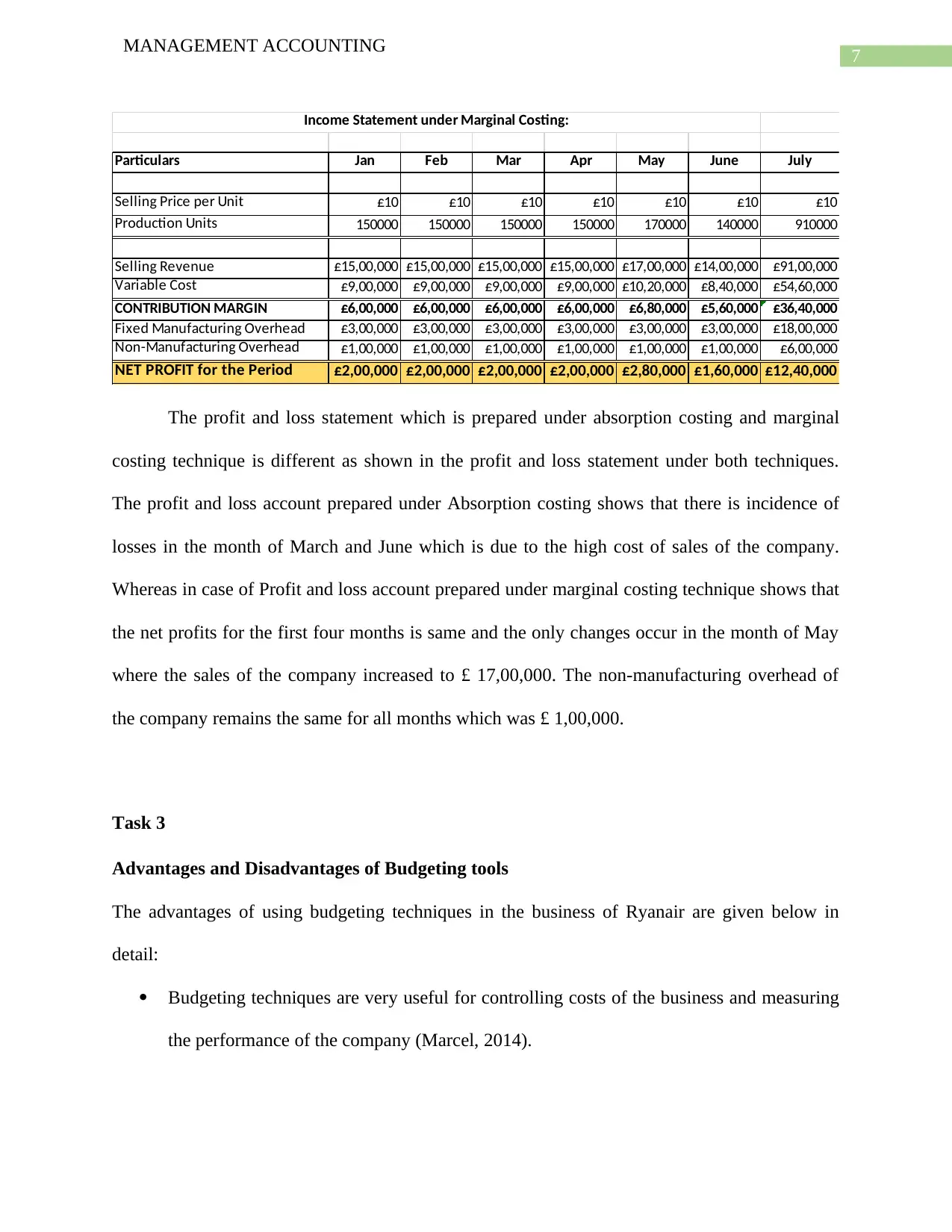
7
MANAGEMENT ACCOUNTING
Particulars Jan Feb Mar Apr May June July
Selling Price per Unit £10 £10 £10 £10 £10 £10 £10
Production Units 150000 150000 150000 150000 170000 140000 910000
Selling Revenue £15,00,000 £15,00,000 £15,00,000 £15,00,000 £17,00,000 £14,00,000 £91,00,000
Variable Cost £9,00,000 £9,00,000 £9,00,000 £9,00,000 £10,20,000 £8,40,000 £54,60,000
CONTRIBUTION MARGIN £6,00,000 £6,00,000 £6,00,000 £6,00,000 £6,80,000 £5,60,000 £36,40,000
Fixed Manufacturing Overhead £3,00,000 £3,00,000 £3,00,000 £3,00,000 £3,00,000 £3,00,000 £18,00,000
Non-Manufacturing Overhead £1,00,000 £1,00,000 £1,00,000 £1,00,000 £1,00,000 £1,00,000 £6,00,000
NET PROFIT for the Period £2,00,000 £2,00,000 £2,00,000 £2,00,000 £2,80,000 £1,60,000 £12,40,000
Income Statement under Marginal Costing:
The profit and loss statement which is prepared under absorption costing and marginal
costing technique is different as shown in the profit and loss statement under both techniques.
The profit and loss account prepared under Absorption costing shows that there is incidence of
losses in the month of March and June which is due to the high cost of sales of the company.
Whereas in case of Profit and loss account prepared under marginal costing technique shows that
the net profits for the first four months is same and the only changes occur in the month of May
where the sales of the company increased to £ 17,00,000. The non-manufacturing overhead of
the company remains the same for all months which was £ 1,00,000.
Task 3
Advantages and Disadvantages of Budgeting tools
The advantages of using budgeting techniques in the business of Ryanair are given below in
detail:
Budgeting techniques are very useful for controlling costs of the business and measuring
the performance of the company (Marcel, 2014).
MANAGEMENT ACCOUNTING
Particulars Jan Feb Mar Apr May June July
Selling Price per Unit £10 £10 £10 £10 £10 £10 £10
Production Units 150000 150000 150000 150000 170000 140000 910000
Selling Revenue £15,00,000 £15,00,000 £15,00,000 £15,00,000 £17,00,000 £14,00,000 £91,00,000
Variable Cost £9,00,000 £9,00,000 £9,00,000 £9,00,000 £10,20,000 £8,40,000 £54,60,000
CONTRIBUTION MARGIN £6,00,000 £6,00,000 £6,00,000 £6,00,000 £6,80,000 £5,60,000 £36,40,000
Fixed Manufacturing Overhead £3,00,000 £3,00,000 £3,00,000 £3,00,000 £3,00,000 £3,00,000 £18,00,000
Non-Manufacturing Overhead £1,00,000 £1,00,000 £1,00,000 £1,00,000 £1,00,000 £1,00,000 £6,00,000
NET PROFIT for the Period £2,00,000 £2,00,000 £2,00,000 £2,00,000 £2,80,000 £1,60,000 £12,40,000
Income Statement under Marginal Costing:
The profit and loss statement which is prepared under absorption costing and marginal
costing technique is different as shown in the profit and loss statement under both techniques.
The profit and loss account prepared under Absorption costing shows that there is incidence of
losses in the month of March and June which is due to the high cost of sales of the company.
Whereas in case of Profit and loss account prepared under marginal costing technique shows that
the net profits for the first four months is same and the only changes occur in the month of May
where the sales of the company increased to £ 17,00,000. The non-manufacturing overhead of
the company remains the same for all months which was £ 1,00,000.
Task 3
Advantages and Disadvantages of Budgeting tools
The advantages of using budgeting techniques in the business of Ryanair are given below in
detail:
Budgeting techniques are very useful for controlling costs of the business and measuring
the performance of the company (Marcel, 2014).
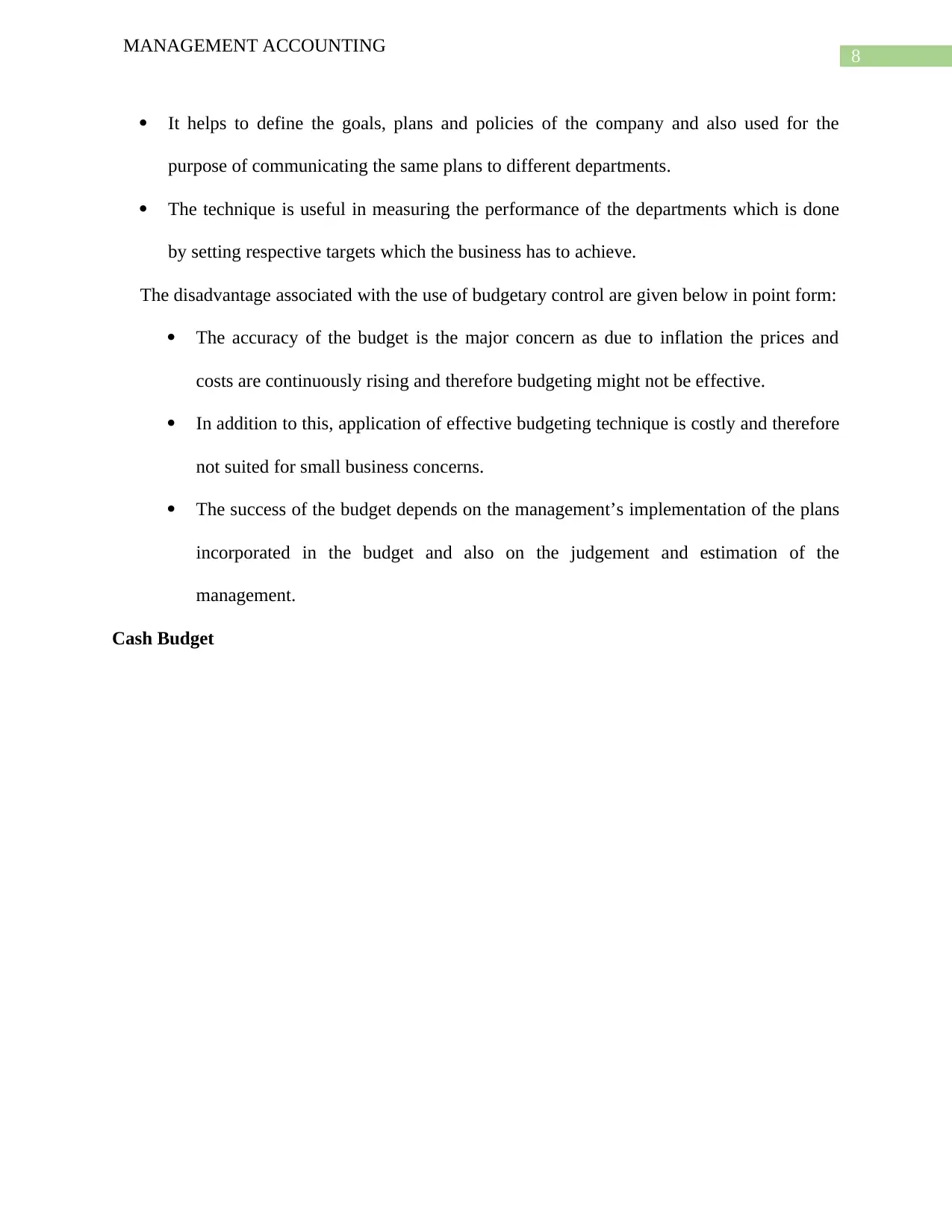
8
MANAGEMENT ACCOUNTING
It helps to define the goals, plans and policies of the company and also used for the
purpose of communicating the same plans to different departments.
The technique is useful in measuring the performance of the departments which is done
by setting respective targets which the business has to achieve.
The disadvantage associated with the use of budgetary control are given below in point form:
The accuracy of the budget is the major concern as due to inflation the prices and
costs are continuously rising and therefore budgeting might not be effective.
In addition to this, application of effective budgeting technique is costly and therefore
not suited for small business concerns.
The success of the budget depends on the management’s implementation of the plans
incorporated in the budget and also on the judgement and estimation of the
management.
Cash Budget
MANAGEMENT ACCOUNTING
It helps to define the goals, plans and policies of the company and also used for the
purpose of communicating the same plans to different departments.
The technique is useful in measuring the performance of the departments which is done
by setting respective targets which the business has to achieve.
The disadvantage associated with the use of budgetary control are given below in point form:
The accuracy of the budget is the major concern as due to inflation the prices and
costs are continuously rising and therefore budgeting might not be effective.
In addition to this, application of effective budgeting technique is costly and therefore
not suited for small business concerns.
The success of the budget depends on the management’s implementation of the plans
incorporated in the budget and also on the judgement and estimation of the
management.
Cash Budget
⊘ This is a preview!⊘
Do you want full access?
Subscribe today to unlock all pages.

Trusted by 1+ million students worldwide
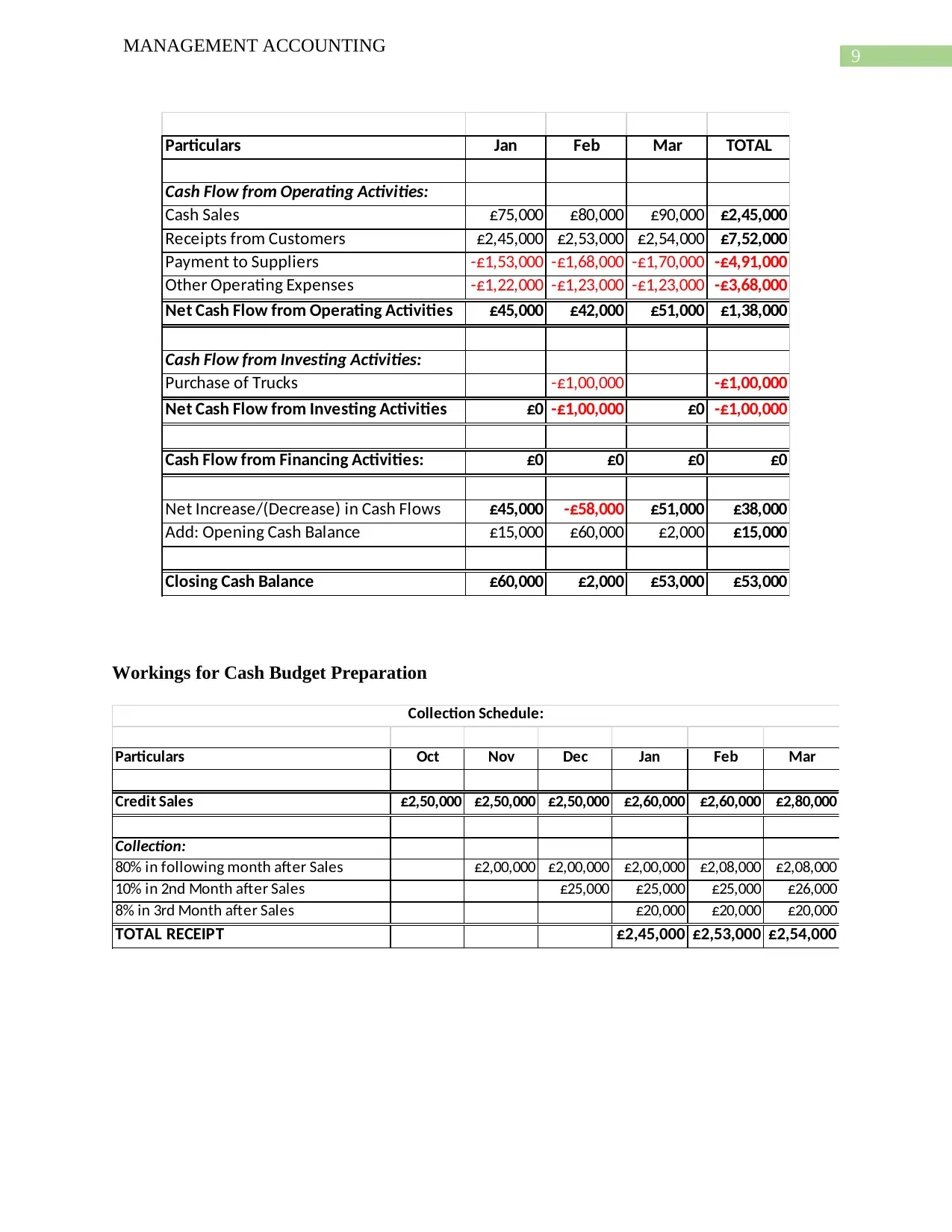
9
MANAGEMENT ACCOUNTING
Particulars Jan Feb Mar TOTAL
Cash Flow from Operating Activities:
Cash Sales £75,000 £80,000 £90,000 £2,45,000
Receipts from Customers £2,45,000 £2,53,000 £2,54,000 £7,52,000
Payment to Suppliers -£1,53,000 -£1,68,000 -£1,70,000 -£4,91,000
Other Operating Expenses -£1,22,000 -£1,23,000 -£1,23,000 -£3,68,000
Net Cash Flow from Operating Activities £45,000 £42,000 £51,000 £1,38,000
Cash Flow from Investing Activities:
Purchase of Trucks -£1,00,000 -£1,00,000
Net Cash Flow from Investing Activities £0 -£1,00,000 £0 -£1,00,000
Cash Flow from Financing Activities: £0 £0 £0 £0
Net Increase/(Decrease) in Cash Flows £45,000 -£58,000 £51,000 £38,000
Add: Opening Cash Balance £15,000 £60,000 £2,000 £15,000
Closing Cash Balance £60,000 £2,000 £53,000 £53,000
Workings for Cash Budget Preparation
Particulars Oct Nov Dec Jan Feb Mar
Credit Sales £2,50,000 £2,50,000 £2,50,000 £2,60,000 £2,60,000 £2,80,000
Collection:
80% in following month after Sales £2,00,000 £2,00,000 £2,00,000 £2,08,000 £2,08,000
10% in 2nd Month after Sales £25,000 £25,000 £25,000 £26,000
8% in 3rd Month after Sales £20,000 £20,000 £20,000
TOTAL RECEIPT £2,45,000 £2,53,000 £2,54,000
Collection Schedule:
MANAGEMENT ACCOUNTING
Particulars Jan Feb Mar TOTAL
Cash Flow from Operating Activities:
Cash Sales £75,000 £80,000 £90,000 £2,45,000
Receipts from Customers £2,45,000 £2,53,000 £2,54,000 £7,52,000
Payment to Suppliers -£1,53,000 -£1,68,000 -£1,70,000 -£4,91,000
Other Operating Expenses -£1,22,000 -£1,23,000 -£1,23,000 -£3,68,000
Net Cash Flow from Operating Activities £45,000 £42,000 £51,000 £1,38,000
Cash Flow from Investing Activities:
Purchase of Trucks -£1,00,000 -£1,00,000
Net Cash Flow from Investing Activities £0 -£1,00,000 £0 -£1,00,000
Cash Flow from Financing Activities: £0 £0 £0 £0
Net Increase/(Decrease) in Cash Flows £45,000 -£58,000 £51,000 £38,000
Add: Opening Cash Balance £15,000 £60,000 £2,000 £15,000
Closing Cash Balance £60,000 £2,000 £53,000 £53,000
Workings for Cash Budget Preparation
Particulars Oct Nov Dec Jan Feb Mar
Credit Sales £2,50,000 £2,50,000 £2,50,000 £2,60,000 £2,60,000 £2,80,000
Collection:
80% in following month after Sales £2,00,000 £2,00,000 £2,00,000 £2,08,000 £2,08,000
10% in 2nd Month after Sales £25,000 £25,000 £25,000 £26,000
8% in 3rd Month after Sales £20,000 £20,000 £20,000
TOTAL RECEIPT £2,45,000 £2,53,000 £2,54,000
Collection Schedule:
Paraphrase This Document
Need a fresh take? Get an instant paraphrase of this document with our AI Paraphraser
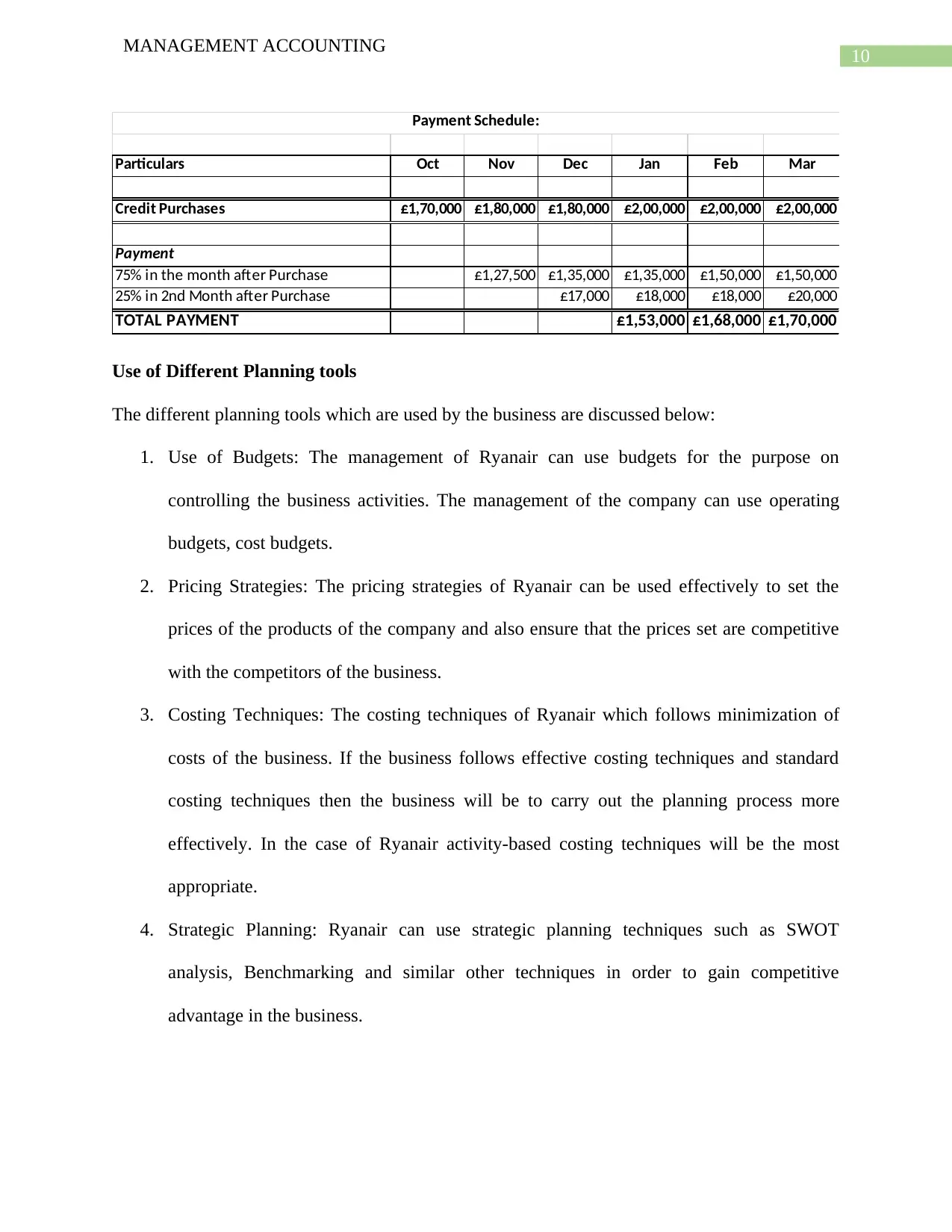
10
MANAGEMENT ACCOUNTING
Particulars Oct Nov Dec Jan Feb Mar
Credit Purchases £1,70,000 £1,80,000 £1,80,000 £2,00,000 £2,00,000 £2,00,000
Payment
75% in the month after Purchase £1,27,500 £1,35,000 £1,35,000 £1,50,000 £1,50,000
25% in 2nd Month after Purchase £17,000 £18,000 £18,000 £20,000
TOTAL PAYMENT £1,53,000 £1,68,000 £1,70,000
Payment Schedule:
Use of Different Planning tools
The different planning tools which are used by the business are discussed below:
1. Use of Budgets: The management of Ryanair can use budgets for the purpose on
controlling the business activities. The management of the company can use operating
budgets, cost budgets.
2. Pricing Strategies: The pricing strategies of Ryanair can be used effectively to set the
prices of the products of the company and also ensure that the prices set are competitive
with the competitors of the business.
3. Costing Techniques: The costing techniques of Ryanair which follows minimization of
costs of the business. If the business follows effective costing techniques and standard
costing techniques then the business will be to carry out the planning process more
effectively. In the case of Ryanair activity-based costing techniques will be the most
appropriate.
4. Strategic Planning: Ryanair can use strategic planning techniques such as SWOT
analysis, Benchmarking and similar other techniques in order to gain competitive
advantage in the business.
MANAGEMENT ACCOUNTING
Particulars Oct Nov Dec Jan Feb Mar
Credit Purchases £1,70,000 £1,80,000 £1,80,000 £2,00,000 £2,00,000 £2,00,000
Payment
75% in the month after Purchase £1,27,500 £1,35,000 £1,35,000 £1,50,000 £1,50,000
25% in 2nd Month after Purchase £17,000 £18,000 £18,000 £20,000
TOTAL PAYMENT £1,53,000 £1,68,000 £1,70,000
Payment Schedule:
Use of Different Planning tools
The different planning tools which are used by the business are discussed below:
1. Use of Budgets: The management of Ryanair can use budgets for the purpose on
controlling the business activities. The management of the company can use operating
budgets, cost budgets.
2. Pricing Strategies: The pricing strategies of Ryanair can be used effectively to set the
prices of the products of the company and also ensure that the prices set are competitive
with the competitors of the business.
3. Costing Techniques: The costing techniques of Ryanair which follows minimization of
costs of the business. If the business follows effective costing techniques and standard
costing techniques then the business will be to carry out the planning process more
effectively. In the case of Ryanair activity-based costing techniques will be the most
appropriate.
4. Strategic Planning: Ryanair can use strategic planning techniques such as SWOT
analysis, Benchmarking and similar other techniques in order to gain competitive
advantage in the business.
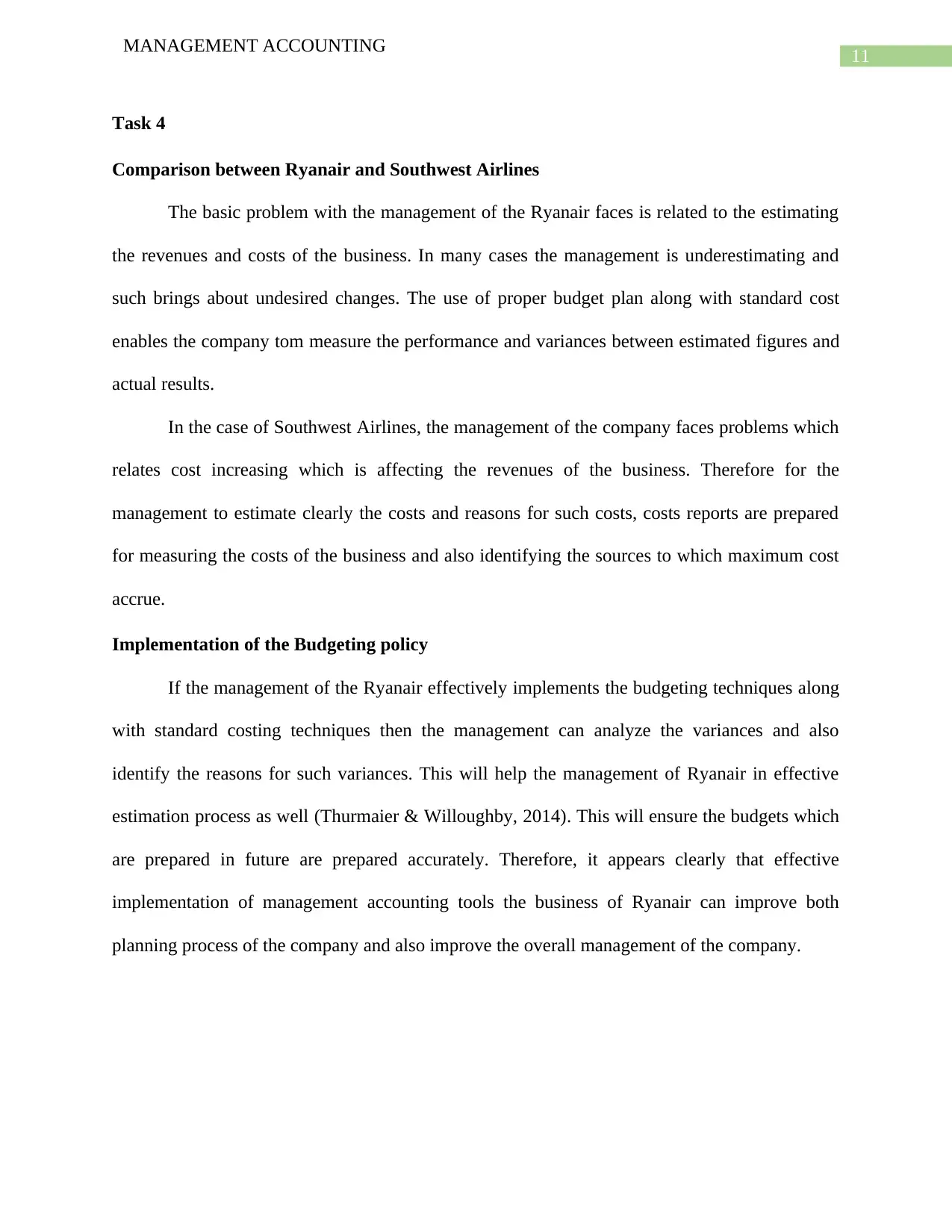
11
MANAGEMENT ACCOUNTING
Task 4
Comparison between Ryanair and Southwest Airlines
The basic problem with the management of the Ryanair faces is related to the estimating
the revenues and costs of the business. In many cases the management is underestimating and
such brings about undesired changes. The use of proper budget plan along with standard cost
enables the company tom measure the performance and variances between estimated figures and
actual results.
In the case of Southwest Airlines, the management of the company faces problems which
relates cost increasing which is affecting the revenues of the business. Therefore for the
management to estimate clearly the costs and reasons for such costs, costs reports are prepared
for measuring the costs of the business and also identifying the sources to which maximum cost
accrue.
Implementation of the Budgeting policy
If the management of the Ryanair effectively implements the budgeting techniques along
with standard costing techniques then the management can analyze the variances and also
identify the reasons for such variances. This will help the management of Ryanair in effective
estimation process as well (Thurmaier & Willoughby, 2014). This will ensure the budgets which
are prepared in future are prepared accurately. Therefore, it appears clearly that effective
implementation of management accounting tools the business of Ryanair can improve both
planning process of the company and also improve the overall management of the company.
MANAGEMENT ACCOUNTING
Task 4
Comparison between Ryanair and Southwest Airlines
The basic problem with the management of the Ryanair faces is related to the estimating
the revenues and costs of the business. In many cases the management is underestimating and
such brings about undesired changes. The use of proper budget plan along with standard cost
enables the company tom measure the performance and variances between estimated figures and
actual results.
In the case of Southwest Airlines, the management of the company faces problems which
relates cost increasing which is affecting the revenues of the business. Therefore for the
management to estimate clearly the costs and reasons for such costs, costs reports are prepared
for measuring the costs of the business and also identifying the sources to which maximum cost
accrue.
Implementation of the Budgeting policy
If the management of the Ryanair effectively implements the budgeting techniques along
with standard costing techniques then the management can analyze the variances and also
identify the reasons for such variances. This will help the management of Ryanair in effective
estimation process as well (Thurmaier & Willoughby, 2014). This will ensure the budgets which
are prepared in future are prepared accurately. Therefore, it appears clearly that effective
implementation of management accounting tools the business of Ryanair can improve both
planning process of the company and also improve the overall management of the company.
⊘ This is a preview!⊘
Do you want full access?
Subscribe today to unlock all pages.

Trusted by 1+ million students worldwide
1 out of 14
Related Documents
Your All-in-One AI-Powered Toolkit for Academic Success.
+13062052269
info@desklib.com
Available 24*7 on WhatsApp / Email
![[object Object]](/_next/static/media/star-bottom.7253800d.svg)
Unlock your academic potential
Copyright © 2020–2025 A2Z Services. All Rights Reserved. Developed and managed by ZUCOL.





